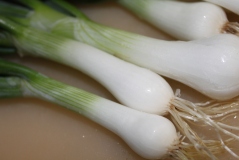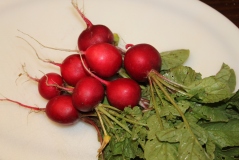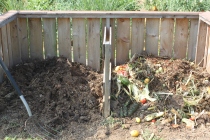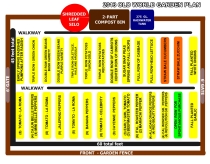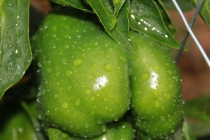5 Simple Tips To Grow A Healthy, Vibrant And Organic Garden!
8
Between all of the frenzied arguments on both sides of the organic vs. non-organic fence – there are some simple, basic processes that we can all follow to improve the fertility and viability of our backyard gardens and raised beds…naturally.
Mary and I do not practice as chemists, scientists or biologists in our spare time – nor is our garden officially certified as “green” or “organic”. But we do have senses - and the sense to know that the food we grow organically tastes and looks great, doesn’t contain any pesticides or sprays - and grows abundantly.
How? by following one simple rule. Take care of the soil that takes care of you. Oh, and by the way – it also make good “cents”…because it’s much cheaper to grow our food organically than buying and applying expensive fertilizers and pesticides.
So through it all…we simply choose to grow organically. And no…we’re not weird! Well, our kids might not agree with that last statement – but in all honesty, we’re a regular couple who just wants to grow and know where our food comes from – and more importantly – know what’s in it, and what’s not.
So with that in mind, here are 5 simple and practical tips we use in our gardens and landscape to grow all of the fruits and vegetables we need – without chemicals or pesticides.
1. Composting:
Composting is the backbone of any organic garden. In fact, compost comes straight from the word decomposition..the very heart of organic matter breaking down into fertile soil. Plant matter, leaves, food, etc. all eventually break down into the soil to add nutrients. However, once you turn that soil and plant your first garden – you begin to take nutrients back out of the soil. So adding compost is a must to keeping your soil strong and vibrant. By adding compost – you are in essence recharging your soil.
Here is how we use it: Every year – we will work a 2 to 3” top-dressing of compost into each of our raised bed rows. Then, at planting time – we will put another cup or so in the average vegetable planting hole, mixing it in with the existing soil. We use it one more time to top dress and mulch our garden plants – doing this once the plants have grown for a few weeks in the soil. We put a good shovel full or two around each plant’s base. This not only provides great weed control and moisture retention – but the compost slowly releases additional nutrients when it rains or when we water – providing a natural fertilizer for the plants.
There are a million ways to go about making compost – in a bin, a tub, a barrel or a plain old pile in the middle of the garden. But whatever you do – get that pile started! Add all of those kitchen remnants – potato peels, coffee grounds, egg shells and more. You can find out more about composting at our link here : Composting 101. Remember that finished compost should be fine and sweet-smelling and cool to the touch. If you are turning the pile and still feeling heat – it’s still cooking and not ready to use on or near plants just yet.
2. Cover Crops:
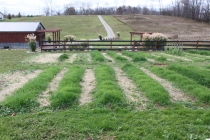
Our raised bed rows planted with their fall blanket of cover crops. These help protect the topsoil through winter, keep weeds from germinating, and add tons of organic matter when we turn it under in the spring
Cover crops are really the key to a long-term garden’s success – and are easy to plant! Just like the big time farmers on big time farms – our gardens and raised beds get all the same benefits of a well-grown cover crop. They add back tons of nutrients including Nitrogen to the soil, keep other weeds from getting established in your beds, and build organic matter back into the earth. They also play a key role in keeping soil erosion to a minimum.
So what are they and when can they be planted? Cover crops are a planting of an annual crop like annual rye or clover to your empty garden beds. Early fall is a great time to plant a cover crop in your garden or raised beds. A crop like annual rye will emerge in just a week or two and create a thick, grassy bed that will fix nitrogen levels in the soil and keep the beds from being exposed to the winter elements that can erode precious topsoil. In the spring, you simply dig them under to add organic matter back into your soil. You can even plant a quick spring or mid summer crop and turn it over into the soil before planting your summer garden. This is called a “green manure or cover crop” and can be a great boost to the plants going into the space.
It’s easy to plant one. No need to till your soil – next, rake out your rows, existing garden, or raised beds – and scatter the seeds as if you were throwing grass seed on your lawn. Rake it over and you’re done! It’s okay if you still see seeds on top – they will sprout soon enough and you will have a great cover crop growing! We don’t use a tiller at all in our raised row beds – just a pitchfork to turn it over, and we are ready to plant. We actually have a complete tutorial dedicated to cover crop benefits that you can check out here : Planting Cover Crops
3. Crop Rotation:
If you keep planting the same pepper, tomato or cucumber plants in the same spot, year after year – you won’t keep getting the same results. Why? Because plants use certain specific nutrients from the soil - and the soil becomes depleted of those nutrients if the same crops keep going into the same place.
In addition – soil borne diseases that are prone to affect a certain type of plant have a better chance to become established with repeat plantings. So, in addition to providing compost and cover crops to recharge your soil – it’s important to rotate your crops each year so that they give the soil time to recover from that specific crop.
For us – we have 34 raised beds in our garden – and we flip and rotate what we grow so that the same crop will not go in the same space until every fourth year. With just a little planning – it’s easy to do.
4. Mulching:
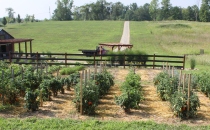
We use mulch around our plants and in our walking rows to keep the garden clean and weeds to a minimum
Remember that statement about plants using nutrients from the soil? Well guess what – weeds are plants too – and they compete for the same nutrients and water your vegetable plants do. So the less weeds they compete with – the more nutrients in the soil for the vegetable plants. And you can suppress those weeds naturally, without spraying, and keep your garden looking great.
How? By mulching. Mulching is a great way to keep out unwanted weeds. We like to mulch around our plants with a healthy dose of finished compost. It not only hold conserves moisture in the soil, but it blocks out weeds, and adds valuable nutrients back to the soil while it decomposes. If you don’t have compost on hand yet – then mulch with straw, shredded leaves or grass clippings. They all accomplish the same thing – keeping moisture in while suppressing weeds. We also mulch all of our walking rows with straw and shredded leaves to keep weeds out from there as well. When after a few weeks we get a few weeds popping up here and there…we simply use a weed-eater and cut them down, add a little more straw, and the garden looks great.
5. Proper Watering:
No matter how good your soil is – without water – plants struggle. Too little water and plants shrivel up. Too much water and they won’t develop the good and deep root structure needed for healthy, mature plants. A good rule of thumb is that a garden plant typically needs to receive about 1 inch of water a week. If mother nature isn’t supplying that - then you need to supplement. But that doesn’t mean the 1″ of water should come all at once. If you are experiencing a prolonged dry spell – water every two to three days with a slow, soaking 1/2″ of water. This allows enough water to go deep into the soil and build deeper roots – and gives the plants more consistent watering. Why not every day? The plants never send their roots deeper to look for water – and you end up with underdeveloped roots, and a weaker plant. Call it tough love watering to develop stronger plants – but it works.
Water early in the day or in the evening to keep evaporation to a minimum. Try to water the ground around the root area and not the foliage – wet leaves can become burned from the sun’s rays. When our plants are young – we use a 2 gallon sprayer (see, there is room for a sprayer in an organic garden  ) – and water directly to the plant’s base to conserve water and get right to where it’s needed most.
) – and water directly to the plant’s base to conserve water and get right to where it’s needed most.
There you have it. Our 5 simple, organic tips to a healthy, vibrant and chemical free garden!
If you would like to receive our weekly DIY and Gardening Posts every Tuesday – be sure to sign up to follow our blog via email, Twitter or Facebook in the right hand column of the blog.
